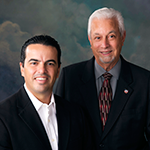When Robert Ontiveros started, in 1974, the company that would become Group O, technology wasn’t what it is today. “He was making deliveries to customers out of the back of a station wagon,” says Robert’s son, Gregg, of the fledgling packaging materials and machinery business. Almost 40 years later, the younger Ontiveros sits at the helm of the Milan, Illinois-based company, and the business has changed drastically, expanding into a multifaceted business-process outsourcing operation.
“My father began in packaging, covering Iowa, Illinois, Indiana, and Wisconsin, but in the early 1980s, with the advent of outsourcing, the company was in a unique position,” says the junior Ontiveros. “We were located about two hours west of Chicago, which is the hub for the agricultural and industrial industries, and we had Case and International Harvester and John Deere and Caterpillar nearby. When they started outsourcing functions that they had been doing in house, we were fortunate enough to be awarded a contract and started our supply chain business.”
Consejos de Papá
“My dad would always say, as I was leaving, ‘Do me a favor—sell something.’ That’s pretty good advice, because, as he’d also always say, ‘Nothing gets done until something gets sold.’ We have a lot of great support people who deliver every day to the customer, but we have to get that customer first. It’s been a mantra here, in a lighthearted way. Things like this illustrate what a great mentor my father has been to me. Often I look back on something he said, like this, and think, ‘Wow, did he really mean to teach me that lesson at that moment, or leave that mark on the business?’ If it was intentional, it was brilliant, and if it wasn’t, I want to thank him anyway.”
Gregg Ontiveros
Today, that supply chain business provides everything from the management and logistics for a six million-square-foot Caterpillar facility to the distribution of wireless handset devices for AT&T. Caterpillar, says Ontiveros, provides a good example of Group O’s capabilities. When the heavy-equipment manufacturer experienced significant growth with an expanding global supply base, it needed a more efficient way to manage suppliers. Group O established inventory and shipping processes to optimize product flow to Caterpillar facilities worldwide, and also implemented the technology to support those processes. This included a fully integrated electronic–data-interchange solution and a web portal that integrates more than 600 global suppliers, which in turn produce more than 3,500 products for Caterpillar. As a result, on-time delivery in Caterpillar’s noncore supplier base increased from less than 30 percent to more than 90 percent.
Today, Group O also offers marketing services to help businesses acquire and retain customers through efficient promotion management, fulfillment, print optimization, and business analytics that help identify new opportunities and uncover information that leads to better business decisions. According to Ontiveros, the utilization of technology has been central to the 1,500-employee company’s success. “In the past, the technology component wasn’t such a big deal, but today there’s a much greater focus on it to create efficiencies, increase velocities, and reduce costs,” he says. “We build web portals; we look for partners offshore. We’re constantly looking at different opportunities to drive costs out of our processes so that we in turn can drive costs out of the supply chains of our customers.”
Another key to the company’s success is its ability to offer the customer, regardless of vertical, what it needs. “We deal with a roster of companies across a number of different verticals, including consumer packaged goods, agricultural, industrial, telecom, retail, and technology, and we’re very good at providing the customer what the customer is looking for,” Ontiveros says. “In the telecom space, for example, we know TL 9000, the telecom equivalent of ISO 9000, inside and out. Once we find out what the customer needs, we try to be that for them.”
Such a process is constant, and Ontiveros has witnessed it firsthand since he joined the business following graduation from Colorado State University in 1985. In 1991, he took over the supply chain business, and became president of the company in 1999. “We’re trying to look for the next blue ocean, if you will—something to migrate to that can give us a competitive advantage that hasn’t been explored yet,” he says, noting that it’s far easier said than done. “The only thing for certain is that things are going to change, so we have to be nimble in order to embrace and capitalize on the change. That’s the challenge in any services space. There are compressed innovation curves and business cycles, so you constantly have to be asking your customers what they’re doing, where they’re going, and you have to constantly be looking at the competitive landscape and adjusting your offerings to go with the next round of change. Because change is coming, and we want to effect the change, not let the change affect us.”
Despite the company’s size, it’s maintained the familial culture that Ontiveros says his father had in mind. “He was one of 12 children born in the United States to immigrant parents from Mexico, and he grew up in a two-bedroom house, yet he managed to build a business brick by brick, customer by customer—the American dream story,” Ontiveros says. “While it gets harder to maintain that family business culture as you grow—because we’re spread out across the country and we have the policies and procedures that companies of this size have—I try to be visible to all employees. I get to all of our locations once a year so I can shake hands, look people in the eye, thank them for a good job, and try to understand their challenges. It’s about more than the bottom line.”

